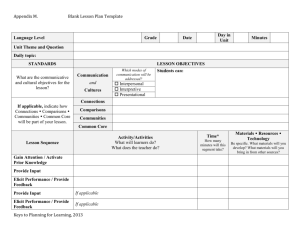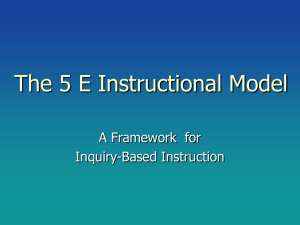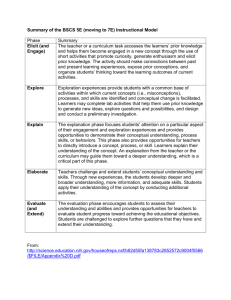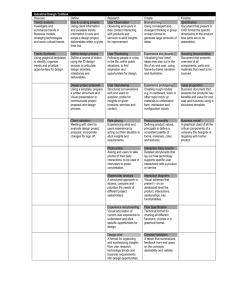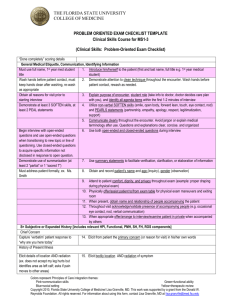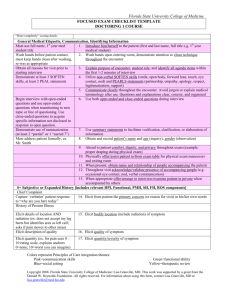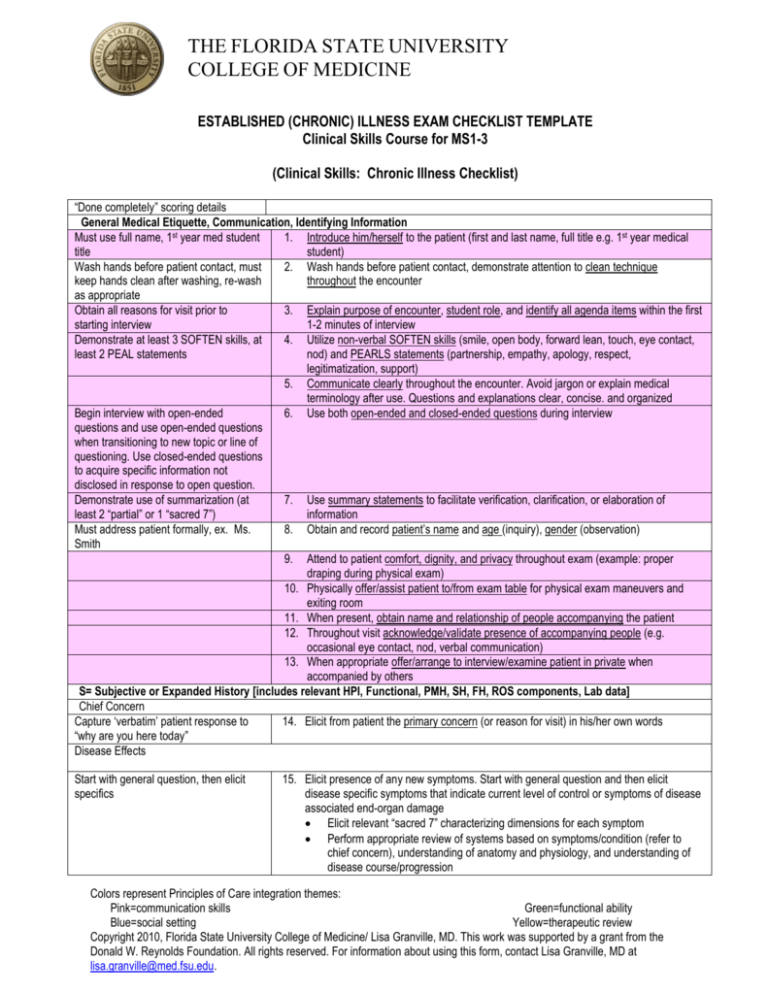
THE FLORIDA STATE UNIVERSITY
COLLEGE OF MEDICINE
ESTABLISHED (CHRONIC) ILLNESS EXAM CHECKLIST TEMPLATE
Clinical Skills Course for MS1-3
(Clinical Skills: Chronic Illness Checklist)
“Done completely” scoring details
General Medical Etiquette, Communication, Identifying Information
Must use full name, 1st year med student
1. Introduce him/herself to the patient (first and last name, full title e.g. 1st year medical
title
student)
Wash hands before patient contact, must
2. Wash hands before patient contact, demonstrate attention to clean technique
keep hands clean after washing, re-wash
throughout the encounter
as appropriate
Obtain all reasons for visit prior to
3. Explain purpose of encounter, student role, and identify all agenda items within the first
starting interview
1-2 minutes of interview
Demonstrate at least 3 SOFTEN skills, at
4. Utilize non-verbal SOFTEN skills (smile, open body, forward lean, touch, eye contact,
least 2 PEAL statements
nod) and PEARLS statements (partnership, empathy, apology, respect,
legitimatization, support)
5. Communicate clearly throughout the encounter. Avoid jargon or explain medical
terminology after use. Questions and explanations clear, concise. and organized
Begin interview with open-ended
6. Use both open-ended and closed-ended questions during interview
questions and use open-ended questions
when transitioning to new topic or line of
questioning. Use closed-ended questions
to acquire specific information not
disclosed in response to open question.
Demonstrate use of summarization (at
7. Use summary statements to facilitate verification, clarification, or elaboration of
least 2 “partial” or 1 “sacred 7”)
information
Must address patient formally, ex. Ms.
8. Obtain and record patient’s name and age (inquiry), gender (observation)
Smith
9. Attend to patient comfort, dignity, and privacy throughout exam (example: proper
draping during physical exam)
10. Physically offer/assist patient to/from exam table for physical exam maneuvers and
exiting room
11. When present, obtain name and relationship of people accompanying the patient
12. Throughout visit acknowledge/validate presence of accompanying people (e.g.
occasional eye contact, nod, verbal communication)
13. When appropriate offer/arrange to interview/examine patient in private when
accompanied by others
S= Subjective or Expanded History [includes relevant HPI, Functional, PMH, SH, FH, ROS components, Lab data]
Chief Concern
Capture ‘verbatim’ patient response to
14. Elicit from patient the primary concern (or reason for visit) in his/her own words
“why are you here today”
Disease Effects
Start with general question, then elicit
specifics
15. Elicit presence of any new symptoms. Start with general question and then elicit
disease specific symptoms that indicate current level of control or symptoms of disease
associated end-organ damage
Elicit relevant “sacred 7” characterizing dimensions for each symptom
Perform appropriate review of systems based on symptoms/condition (refer to
chief concern), understanding of anatomy and physiology, and understanding of
disease course/progression
Colors represent Principles of Care integration themes:
Pink=communication skills
Green=functional ability
Blue=social setting
Yellow=therapeutic review
Copyright 2010, Florida State University College of Medicine/ Lisa Granville, MD. This work was supported by a grant from the
Donald W. Reynolds Foundation. All rights reserved. For information about using this form, contact Lisa Granville, MD at
lisa.granville@med.fsu.edu.
THE FLORIDA STATE UNIVERSITY
COLLEGE OF MEDICINE
What do you think is causing this
What worries you about this, what fears
do you have about this
Impact on at least 1 of 3
Functional History (Baseline)
Elicit at least 2 ADLs, 2 IADLs
Past Medical History
Elicit all drugs used
Elicit at least 4 of 5 details for each
Elicit all drugs used
Elicit at least 4 of 5 details for each
Elicit all approaches used
Elicit at least 4 of 5 details for each
Which questions to include depends on
individual case
Personal and Social History
Elicit both
Elicit yes or no AND if yes, name or
relation of identified person (ex. my son)
Which questions to include depend on
presenting concern and situation
16. When appropriate elicit patient’s explanation about why this problem/concern is being
presented today/now
17. Elicit patient's ideas, hypotheses/theories about cause(s) of symptoms/ condition
18. Elicit patient's worries/fears about cause(s)/implications of symptoms/ condition
19. Elicit impact of symptoms/condition on daily life (e.g. work, ADLs, IADLs, social
relationships, self-concept)
20. Elicit baseline functional ability 2 items in each of 2 areas: 1. ADLs (bathing, dressing,
grooming, mobility noting aides, continence, feeding), 2. IADLs (phone use, med use,
shopping, cooking, cleaning, finances, transportation)
21. When appropriate elicit patient information about:
o
AADLs (occupation, school, church, recreation)
22. Elicit information about all current prescription medications including dosage,
frequency, indication, effectiveness, side-effects, adherence. Elicit presence of any new
medication
23. Elicit information about all current non-prescription medications including dosage,
frequency, indication, effectiveness, side-effects, adherence
24. Elicit information about all non-medication approaches including “dosage”, frequency,
indication, effectiveness, side-effects
25. When appropriate elicit patient information about:
o Potential drug-drug interactions
o Therapeutic duplications
26. Elicit information about household members and environment
27. Elicit information about presence of a support system for physical illness/impairment
and emotional upset
28. When appropriate, elicit patient information about:
o
Occupation
o
Diet, exercise
o
ETOH, tobacco, recreational drugs
o
Sexual activity
o
Religious practice / spirituality
Family History
29. When appropriate, elicit patient information about blood relatives having illness/
condition with features similar to patient’s current illness/condition; and conditions that
tend to run in family
Disease Monitoring Lab Data
30. Elicit information about any disease monitoring lab data available (including home
measurements)
O= Objective or Focused Physical Exam [includes VS and relevant systems exams]
General Observations, Vital Signs
Recorded in SOAP note
31.
32.
Note age comparison, apparent gender, body habitus, consciousness level,
demeanor, health status, notable characteristics
Review and reassess abnormal (or missing) VS: pulse rate and respiratory rate (per
minute with pattern/ quality), blood pressure (one arm, note position), temperature
(degrees, scale, note how taken)
Colors represent Principles of Care integration themes:
Pink=communication skills
Green=functional ability
Blue=social setting
Yellow=therapeutic review
Copyright 2010, Florida State University College of Medicine/ Lisa Granville, MD. This work was supported by a grant from the
Donald W. Reynolds Foundation. All rights reserved. For information about using this form, contact Lisa Granville, MD at
lisa.granville@med.fsu.edu.
THE FLORIDA STATE UNIVERSITY
COLLEGE OF MEDICINE
33.
When appropriate, perform additional VS maneuvers: compare BP in each arm,
assess orthostatic changes, etc.
34.
Perform appropriate systems exams based on symptoms/condition (refer to chief
concern), understanding of anatomy and physiology, and understanding of disease
course/progression
35.
MS1
MS2
Bring session to closure, verbally state plan to share information with physician,
physically offer/assist patient readiness for room departure
Bring session to closure, verbally state assessment and care plan, physically
offer/assist patient readiness for room departure
Bring session to closure, verbally state assessment and negotiate care plan based
on realistic expectations, physically offer/assist patient readiness for room
departure
Document encounter (SOAP note)
S= subjective or expanded history (both positive and negative)
O= objective or physical exam, laboratory data, imaging
A= assessment or differential diagnoses, present and anticipated problems
P= plan including diagnostic testing, therapeutic management (drug & non-drug;
consider adjustments to minimize drug induced side effects, consider adjustments
needed because of liver or kidney damage), patient education with rationale for
each of these decisions
Symptom guided physical exam
Closure of encounter
MS3
36.
Tips for SOAP Note Documentation
Include all required components indicated in each section
Do not use abbreviations
Include only subjective information in the S
o Suggest use of complete sentences
Include only objective information in the O
o Suggest itemized list of exam areas
Associate each plan with its corresponding assessment
Be sure P addresses 3 items: diagnostic testing, management approaches, patient education with rationale for these decisions
(if an item is not indicated put none; for example diagnostic testing none)
Colors represent Principles of Care integration themes:
Pink=communication skills
Green=functional ability
Blue=social setting
Yellow=therapeutic review
Copyright 2010, Florida State University College of Medicine/ Lisa Granville, MD. This work was supported by a grant from the
Donald W. Reynolds Foundation. All rights reserved. For information about using this form, contact Lisa Granville, MD at
lisa.granville@med.fsu.edu.
THE FLORIDA STATE UNIVERSITY
COLLEGE OF MEDICINE
Explanation of the chronic illness template by section:
Overview:
The medical student curriculum preferentially emphasizes the evaluation of new patient complaints and identification of new
patient diagnoses. This emphasis on “new complaints” and “differential diagnoses” may result in neglecting issues important for
managing patients with previously diagnosed, otherwise stable chronic diseases. The clinical paradigms for these two clinical
situations—the “new patient, new problem, differential diagnosis” and the “established patient with an otherwise stable chronic
disease”—are inherently different. Though both are “investigative processes,” one begins with the new symptom and the other
begins with a known chronic disease/condition. The chronic disease clinical paradigm below begins with a known chronic
disease/condition, and investigates those aspects necessary for successful chronic disease management.
General Medical Etiquette, Communication, Identifying Information
Given FSU COM mission to achieve patient centered, compassionate care these items will be routinely reinforced and thus will
appear on every checklist.
Disease Effects:
Ask about significant disease-specific symptoms that may indicate the current level of control or symptoms of diseaseassociated end-organ damage). This is a key area for the demonstration of clinical reasoning.
Examples:
i) For the diabetic patient there may be both symptoms of control/lack of control and symptoms of end-organ damage:
“Have you experienced lightheadedness or fainting? Any changes in urination, appetite or weight? Any fatigue or loss
of energy? Any problems with concentration or thinking? Have you been checking your feet and have you had any
sores?”
ii) For the patient with known depression it is more an issue of control/lack of control: “What is your mood today? Have
you experienced any sadness, hopelessness or low self-esteem? Any decrease of interest or pleasure in pleasurable
activities? Any changes in appetite or weight? How are you sleeping? How is your energy level? How is your memory
or ability to concentrate?
iii) For asymptomatic disease like HTN and high cholesterol, it may be about end-organ damage only: “Have you had any
chest pain or shortness of breath?” “Have you had pain in your legs when walking?”
An exploration of the patient’s perception of the symptom/condition (relates to previous symptoms, why presenting now,
ideas/hypotheses). If an item is not relevant it is removed from the case specific list as an exception. Note these items facilitate
achievement of patient centered, compassionate care; identification of diagnoses and disease course; and opportunities for
patient education and reassurance.
An exploration of the functional impact of the symptom/condition (relates to the severity of the problem, urgency of need for
intervention, and often correlates with diagnostic/prognostic information)
Functional history will include:
Functional ability prior to condition onset/exacerbation to put the current symptom/condition in context. Functional ability is an
independent predictor of morbidity/mortality and often influences management approaches.
PMH will include:
Significant medical conditions, meds (prescribed, OTC), non-med approaches, and allergies to put the current
symptom/condition in context. This is relevant in all cases for both diagnostic, prognostic, and therapeutic considerations. For
example: new symptoms may relate to disease exacerbation, disease progression, adverse drug events, or another medical
condition; planning of care requires coordination with existing therapy, medical conditions and patient goals.
Colors represent Principles of Care integration themes:
Pink=communication skills
Green=functional ability
Blue=social setting
Yellow=therapeutic review
Copyright 2010, Florida State University College of Medicine/ Lisa Granville, MD. This work was supported by a grant from the
Donald W. Reynolds Foundation. All rights reserved. For information about using this form, contact Lisa Granville, MD at
lisa.granville@med.fsu.edu.
THE FLORIDA STATE UNIVERSITY
COLLEGE OF MEDICINE
SH will include:
Household members, environment, and social support to put the impact of the current symptom/ condition in context. This is
relevant in all cases for both diagnostic and therapeutic considerations. For example, if a person has compromised self care
capacity it is necessary to know if resources exist in the home to meet these needs or if medical management needs to include
provisions for self care. A visually impaired patient with diabetes mellitus on insulin therapy may be facilitated to live alone by
having family preload syringes and store in refrigerator.
SH & FH will include:
Questions about relevant risk factors, lifestyle choices, and stressors related to the presenting concern and underlying medical
conditions.
Disease monitoring lab data:
Patient and provider gathered lab data should be reviewed at each visit. For example a diabetic patient may be keeping a home
log of blood glucose measurements, an obese patient may be keeping track of weight, a patient with high cholesterol may have a
chart of blood cholesterol levels. This is an important area for evaluating the patient’s understanding of the condition, the
effectiveness and adequacy of management, and evidence of disease progression. This is another key area for the
demonstration of clinical reasoning.
O= Objective or Focused Physical Exam [includes VS and relevant systems exams]
General observations are always relevant and contribute to acuity of situation. Vital signs are always relevant, also contribute to
acuity awareness.
Symptom guided physical exam: As described on the checklist and in correlation with questions about associated symptoms,
the physical exam maneuvers should relate to the presenting concern, an understanding of anatomy, physiology, disease
course, and progression, and start with broad consideration rather than prematurely narrowing options. This is another key
area for the demonstration of clinical reasoning.
Colors represent Principles of Care integration themes:
Pink=communication skills
Green=functional ability
Blue=social setting
Yellow=therapeutic review
Copyright 2010, Florida State University College of Medicine/ Lisa Granville, MD. This work was supported by a grant from the
Donald W. Reynolds Foundation. All rights reserved. For information about using this form, contact Lisa Granville, MD at
lisa.granville@med.fsu.edu.

